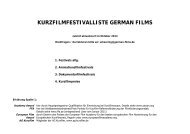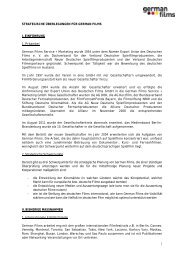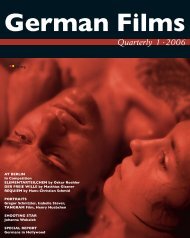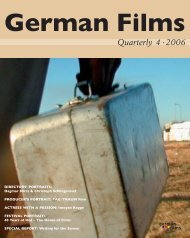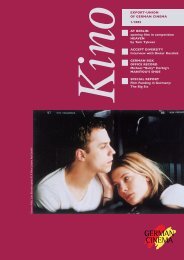Titel Kino 2/2001(2 Alternativ) - German Films
Titel Kino 2/2001(2 Alternativ) - German Films
Titel Kino 2/2001(2 Alternativ) - German Films
You also want an ePaper? Increase the reach of your titles
YUMPU automatically turns print PDFs into web optimized ePapers that Google loves.
FILM ARCHIVES<br />
Film was the most important medium of the 20th century – we<br />
cannot say as yet whether it will remain so in the 21st. It has left<br />
traces behind: in people’s collective memory, and in the form of<br />
film copies, screenplays, architectural set designs, film posters and<br />
film criticism. And although it has made such a deep impression<br />
on us, film is a fleeting art. The film material itself decomposes,<br />
and materials used in production have been, and still are often<br />
thrown away carelessly. The task of film archives and film<br />
museums is to save the traces of film history, but also to make<br />
them usable and show them to the public. The fact that there are<br />
so many of these in the Federal Republic of <strong>German</strong>y is a consequence<br />
of the historical development of post-war society in<br />
<strong>German</strong>y.<br />
A race against time<br />
The history of film began more than 100 years ago, and yet<br />
decades passed before the first public film archive began work.<br />
Because this happened very late, the majority of films from the<br />
age of silent films must be considered irretrievably lost. In a<br />
<strong>German</strong>y which was forcibly made to conform during the NS<br />
regime, the film archives of the Third Reich opened on 4 February<br />
1935 in the presence of Hitler and Goebbels. It was almost<br />
certainly the role of film in the Nazis’ propaganda system which<br />
promoted the establishment of a central <strong>German</strong> film archive,<br />
8<br />
Marlene Dietrich Room/Film Museum Berlin (photo © Scherhaufer)<br />
but it was no coincidence that it happened at this time: people<br />
were beginning to take film seriously as an art form, but also as an<br />
educational medium and as an historical source.<br />
The Second World War produced a caesura here as well. Looking<br />
back over time, the federal <strong>German</strong> archive situation during the<br />
post-war period appears to have been something of a temporary<br />
system. The collections of the Reich’s film archives – around<br />
12,000 films at the end of the war – were placed at the legal<br />
disposal of the allies. It was a private initiative which led to the<br />
foundation of the first archive of the post-war era: after the war,<br />
the collector Hanns Wilhelm Lavies made efforts to<br />
re-assemble scattered exponents from the archives in Berlin and<br />
the western zones, and in 1947 he founded his “Archive for Film<br />
Science”, which became the “<strong>German</strong> Institute of Film<br />
Sciences” (DIF) in 1949. It was not until some time later<br />
that the two directly government archives were set up: the<br />
Federal Archives, at that time in Koblenz, in 1954, and the State<br />
Film Archives of the <strong>German</strong> Democratic Republic (GDR) in East<br />
Berlin during the same year. After the unification of the two<br />
<strong>German</strong> states, this passed over into the Federal Archives<br />
(Film Archive). The third large archive in the Federal Republic,<br />
the Film Museum Berlin-Deutsche Kinemathek<br />
(SDK) – a foundation established in 1963 – also owes its basic<br />
stock to a private collector, the film director Gerhard<br />
Lamprecht.



